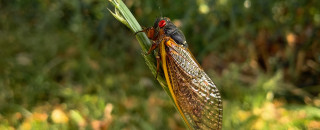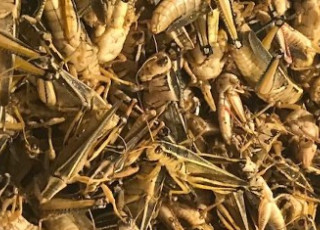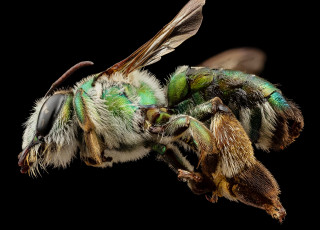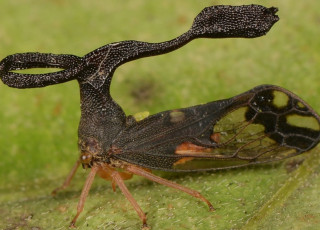The Periodical Cicada Emergence of 2024
By Jude Coleman
After spending most of their life underground, cicadas across North America are taking to the trees to sing their loud, buzzing song. In Illinois, the cicadas emerging this year are particularly special. Two separate broods of bugs — brood XIX and XIII, which emerge every 13 and 17 years, respectively — are appearing together. That hasn’t happened in over 200 years.
“Between the two of those two broods, there’s going to be billions of insects crawling out of the ground and flying around,” said Jason Cryan, an entomologist and the Sarah B. George Executive Director of the Natural History Museum of Utah.
Cicadas fall into two categories: annual and periodical. Periodical cicadas, which only live in Midwestern and Eastern states, spend either 13 or 17 years underground before coming out as adults in mass, synchronized emergences, while annual cicadas, which live all over North America and other parts of the world only spend a few years underground before appearing above ground in smaller, non-synchronized emergences. As the summer solstice creeps closer, Utah’s annual cicadas are just beginning to pop out of their subterranean digs.

Image via Unsplash
Of the roughly half million insects in the Natural History Museum of Utah’s invertebrate zoology collection, around 2,000 are cicadas from around the globe. Visitors can see several examples of these cicadas, including some annuals native to Utah, in a display in the fourth floor Museum’s Life Gallery. There are around 3,000 species of cicadas on Earth, and nearly 200 of them live in North America. Over a dozen live in Utah and are typically black with small orange stripes and spots.
Regardless of whether they are a periodical or an annual, all cicadas' lives begin the same, by hatching from an egg laid inside the branch of a tree. After hatching, the baby cicada — called a nymph — tumbles to the ground. Nymphs have special front legs that are designed for digging, and they use their legs to burrow underground beneath the tree. Once below the tree, they feast.
Unlike many other insects, cicadas don’t have mouth parts for chewing. Instead, they’re equipped with more of a straw, used to suck liquid out of plants. Nymphs poke their mouth straws into the roots of trees and drink xylem sap. Xylem sap transports water and nutrients from the roots of a plant up to its leaves. You may also like xylem sap – on your pancakes! Maple syrup is concentrated xylem sap from maple trees.
The problem with every meal coming from a xylem buffet is that xylem fluid isn’t very nutritious, Cryan said. It takes a long time for nymphs to get the energy and nutrients they need to develop — so they stay underground for several years. In addition to getting enough nutrition, the exact timing of their emergence is related to temperature. In order to emerge in late spring and early summer, cicadas need a certain number of warm days.
“They’re snug as a bug,” Cryan said. “They're below the freeze line, and they're just happily protected from predators and parasites.”
Here is where the two types of cicadas differ. Periodical cicada broods will spend over a decade underground, and will only emerge after either 13 or 17 years. Every brood is synchronized, meaning all clutches of the same brood will all emerge at the same time, to the point where their arrival is easily predictable. Every five to six years, broods from both 13- and 17-year groups will emerge, as they are this year.
But annual cicadas aren’t synchronized. While individual clutches will typically emerge together, clutches laid in the same year won’t necessarily. In other words, one clutch might emerge after two years, and another clutch from the same year might emerge after three or four.
“All cicadas do the same thing. It’s just a matter of how long it takes,” Cryan said.
Scientists aren’t sure why periodical cicadas evolved to spend so much time underground, or why they are found in only a small pocket of the world. One theory insect experts have is that nymphs evolved a longer developmental period as a response to glaciation in the eastern U.S. Another theory is that the trait evolved as a way of avoiding predators. Specialist predators of cicadas, such as the cicada wasp, have annual life spans; by spending more time underground, cicadas could outlive many of these predators.
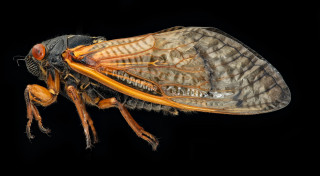
Image via USGS Bee Inventory and Monitoring Lab / Public Domain
Once the cicadas are back on the sunny-side of the ground, they set their sights on trees, where they perch in wait for a mate. Males play a chorus of buzzing, chirping, and whining noises, a din that can sometimes rival lawnmowers in intensity. Each species of cicada has their own unique call, which is used to attract females.
Cicadas play these songs from an organ called a tymbal, located in the first section of the cicada's abdomen. It’s a thin, flat membrane, similar to a drum skin. When a cicada flexes its abdomen, their tiny “drums” flex as well, making a popping sound. They repeat those contractions at lightning speed, making each pop sound like one continuous drone. This differs from other noisy arthropods, such as locusts, who make their sounds by rubbing body parts together.
“Often people refer to cicadas as locusts, but they're not,” Cryan said. “Locusts, which belong to the group of insects including grasshoppers and crickets, can be damaging to crops,” he added, while cicadas don’t pose a threat to agriculture or backyard gardens. At most, a large amount of nymphs below one tree could slow its growth, but neither nymph nor adult cicada will defoliate a tree or permanently damage its root system. Cicadas’ closest relatives are actually spittle bugs, which are also xylem-feeders.
“People shouldn’t be scared of them,” he said. “They can't harm you in any way…they’re really evolutionarily fascinating animals.”
Learn more about invertebrates at the Natural History Museum of Utah.
